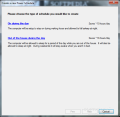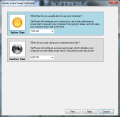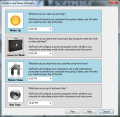Power Options applet under Windows is known to few desktop users either because accessing it requires opening up the Control Panel screen or because they are simply not interested in creating a power plan designed to reduce energy consumption of the machine when it is not used. SetPower, on the other hand, comes to fix both issues by allowing you to create power plans that fit your daily routine.
The version we put under the scope today is free, but there is also an enterprise edition destined for business use, which comes with an extended set of features. The cost of the paid product is a mere $5 and the minimum order is 5 licenses. But this one, among others, includes support for wake-on-lan to the server and remote waking of the machine.
SetPower brings in a minimalist interface with a screen reserved for displaying the user-designed power plans. At the beginning the screen is empty; but you can start defining the criteria for conserving energy either guided by a wizard that helps you customize the details according to your computer usage habits or by picking one of the three Windows power plans (“balanced”, “power saver” and “high performance”) and rig it up with your own adjustments.
If you follow the wizard you have to choose a schedule that best fits you. Thus, you can configure it to use a high performance plan during the work hours which you define, and a power saving one when this period expires.
If you want more control and more tweaking, you can create a custom power plan, which allows you to set the amount of inactivity time that should turn off the display and the hard disk(s). The adjustments are based on the Windows presets for “Balanced”, “Power Saver” and “High Performance”.
Starting with one of these setups you can customize the inactivity time for the display or the hard disk(s) to go off. Additionally, you can make the system enter sleep or hibernate mode if it is not used. You can prevent the machine from entering sleep mode if it is in the process of media sharing.
The difference from what Windows offers in terms of power planning is that SetPower features the possibility to enable one the set schedule for a specific number of days. Microsoft’s operating system applies the settings regardless of the day of the week or time. Thus, with SetPower you can enforce multiple plans that are bent around your computer usage routine.
However, there are choices available in Windows’ Power Options applet, which are not present SetPower, under advanced power options. These give you much more flexibility in deciding how the computer should manage power as they cover a wider array of options, such as wireless adapter behavior, processor power management, PCI express power options and even the JavaScript Timer Frequency mode for Internet Explorer.
On the upside, SetPower will transfer all the customization you make straight into your operating system’s power options, so it basically acts as an extension to what Windows offers by default. The result is that all the plans you create in SetPower are automatically visible in Power Options applet, so you can access the advanced options area for them as well.
Also an important aspect is the fact that this third party freebie does not linger in system tray area cluttering the section with its icon nor does it keep its process running in the background. As soon as you design the power plan and close the application it’ll stay closed, since your settings are already available in Windows Power Options applet.
During our tests the application automatically switched to various power plans at the exact time we set even if the program was closed. This is possible because SetPower uses Task Scheduler to program the power plan switch. The active power scheme would be noticeable in the Power Options applet in Windows and configurable through the advanced options area.
SetPower should not be viewed as a stand-alone application which acts separately from the Power Options in the operating system. It comes to enlarge the customization settings already available by allowing you to create schedules for them to enter into force.
Every power plan you create is also available in Windows Power Options, which offers access to advanced settings for any of the plans created with SetPower. Even if you can start editing a scheme already in the list by double clicking it, it would be nice to have a button assigned for this function. The application does a great job and does not need to run in the background eating system in order to fulfill its tasks because it programs the power scheme shifts in Windows Task Scheduler, like so many other third party applications. All in all SetPower is a great addition to your operating system if you’re looking to conserve energy and even cut down the power bills.
The Good
The Bad
The Truth
 14 DAY TRIAL //
14 DAY TRIAL // 




